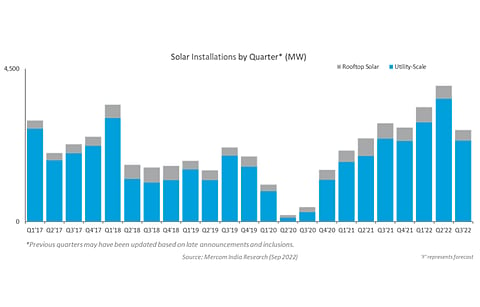

Even as Indian solar installations in Q3/2022 declined 32% sequentially and 6.6% annually, during 9M/2022 the total for the year went up to over 10 GW because of which Mercom Capital Group CEO Raj Prabhu believes, this will be India's 'best' year for solar to date.
In comparison, India installed 10 GW in all of 2021 and was 210% annual increase (see 10 GW New Solar Installed In India In 2021).
The 2.7 GW installed in Q3/2022, large scale accounted for 88% and rooftop 12%. Rajasthan and Maharashtra led installations during the quarter. According to Mercom, the average system cost of large-scale solar projects went up 0.4% on quarterly basis, and 7.5% YoY, thanks to the increase in ASP of modules.
On the upside, several government agencies tendered more than 14 GW PV capacity reflecting a rise of 56% QoQ and 144% YoY.
During 9M/2022, India installed more than 12 GW of new power capacity out of which solar power represented 76% share, stated Mercom in its latest report Q3 2022 India Solar Market Update. Utility scale solar accounts for 9 GW of this 10 GW, with a 45% annual increase.
At the end of September 2022, of 60 GW cumulative installed large scale solar capacity of the country, Rajasthan had more than 27% of large-scale installations at the national level with more than 14 GW deployed.
Mercom notes India's utility scale project pipeline as exceeding 58 GW now as nearly 46 GW of tendered projects await auction.
While the future looks bright there are some headwinds as Prabhu points out 'the domestic supply and demand mismatch could hold the sector back in the short term'. He also cautioned that unless there is a clear resolution to the uncertainty related to environmental concerns surrounding the Great Indian Bustard (GIB) in Rajasthan, delays will continue to impede large scale projects.
Due to the GIB related concerns, 4.8 GW of solar projects await clearance from the Technical Expert Committee, as per Mercom and some of the projects have had to shift the commissioning dates to the next year. There is ambiguity regarding transmission lines since the committee sees 33kV and below power lines as being feasible to be laid underground to protect the birds, but not 66 kV and above, it added.
Complete report can be purchased from Mercom's website.
Previously, another market intelligence and research firm JMK Research forecast India to exit 2022 with 20 GW solar PV capacity (see India's H1/2022 PV Installations Up 71% To 8.4 GW).
